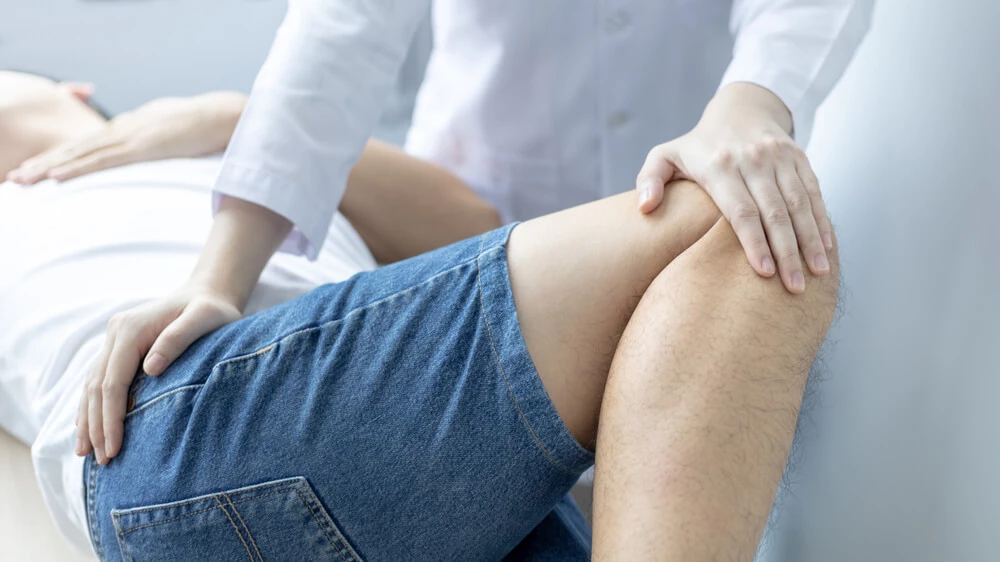Having hyperextended knee can be a world of discomfort.
Your leg is made to bend back and stay straight when you bring it forward. But injury can cause the exact opposite: a leg that bends beyond the straightened position. When this happens, the pain can be unbearable.
A hyperextended knee can also lead to severe ligament damage. A mild hyperextended knee can be treated by your chiropractor but serious cases may require surgery.
The severity of your condition depends on the nature of the injury as well as your personal level of health.
By learning about the causes and symptoms of hyperextended knee, you can take measures to prevent it and seek appropriate care when it happens.
HOW DO I KNOW IF I HAVE HYPEREXTENDED KNEE?
Hyperextended knee is often pretty easy to identify. The knee is bent upwards beyond the straight position it’s supposed to have. It looks like when your children bend the legs of their barbie dolls in the wrong direction.
There are certain key symptoms that typically accompany hyperextended knee.
Pain is the most obvious tell. The pain is sharp, acute, and focused around the knee area–the area of injury.
In the moment of injury, most people hear or feel a pop in their knee. This “popping” sound is a major clue that the ensuing pain is related to hyperextended knee.
Shortly after the injury occurs, bruises start to appear around your affected knee.
Hyperextended knee impairs your motion. You find yourself unable to move your leg like normal.
You may also notice the accumulation of water in your knee joint. It starts to swell up. This condition called “water on the knee” any movement extremely uncomfortable.
In less severe cases, the pain may not be as strong. But instability in your knee and the constant feeling of buckling is a sign that you have hyperextended knee.
WHAT CAUSES HYPEREXTENDED KNEE?
You’re probably wondering “why do you get hyperextended knee?”
Your knee hyperextends, or goes beyond its appropriate range of motion, when inordinate stress is placed on your knee joint ligaments. The most commonly affected ligaments are anterior cruciate ligament (ACL) and the posterior cruciate ligament (PCL).
The kind of force strong enough to provoke hyperextended knee is usually related to sports and accidents.
Contact sports like football and lacrosse are common culprits. But even running can lead to hyperextended knee if you push yourself beyond your limits or don’t use proper technique.
Many times, hyperextended knee incidents are caused by an athlete unexpectedly placing all their weight on one leg. This can happen in basketball, for instance, when he goes to make a shot.
Naturally, the impact of being tackled in football or rugby can be enough to push the femur over the patella in a way that puts excess stress over the ligaments in your joint.
The most serious cases of hyperextended knee typically happen during car accidents. Automobile collisions are massive impacts that can cause major damage to your knee’s surrounding tissue and cartilage.
HOW DO YOU PREVENT HYPEREXTENDED KNEE?
Knowing what leads to hyperextended knee makes it easier to stop it from happening in the first place.
If you play high contact sports, you may not have control over the actions of the other athletes on the field. But doing your part can go a long way. Especially when it comes to practicing adequate technique.
Don’t overexert yourself. Know your limits and stay within them. If you haven’t been active in years, don’t start out running miles and miles.
Always stretch and warm up. Skipping stretching is just inviting something to go wrong.
Use good form. And avoid doing cardio on hard surfaces if possible. Because pavement doesn’t give under your step, it places more stress on your joints.
Preventing hyperextended knee is extremely important. If it happens to you once, you may permanently damage your ligaments, increasing the chances of it happening again.
TREATMENT FOR LESS SEVERE CASES
Most of the hyperextended knee cases that occur on the sportsfield are treatable without surgery. The depth of care depends from case to case, but the following elements are normally helpful:
Getting plenty of rest with your leg elevated is a must. You’ve got to give the ligaments enough time to heal. For minor cases, recovery time can be between 2-4 weeks.
Ice and compression should be part of your treatment. They speed up the healing process and provide relief from the pain and inflammation.
If the pain is too much to bear, you can take over-the-counter pain medications like ibuprofen.
You may benefit from the use of a knee brace while you get back on your feet. Knee braces help prevent further injury.
You should definitely consider a chiropractor. Contrary to popular belief, chiropractors aren’t just for your spine. A chiropractor who works with all joints can be of invaluable assistance.
HYPEREXTENDED KNEE SURGERY
In the more extreme cases of hyperextended knee surgery, most often those involving a car crash, surgery may be needed.
Hyperextended knee surgery comes in two types:
Arthroscopy is used for the smaller injuries. During this procedure, the surgeon inserts an endoscopic camera into the affected area to assess the condition and make necessary repairs.
In Reconstruction Surgery, torn ligaments are removed and replaced using a graft.
Surgery is followed by a period of recuperation and physical therapy that may last as long as six months.
CONCLUSION
Hyperextended knee surgery isn’t a light matter. Not only is it painful. If not treated properly, it can have a long-term impact on your physical performance.
So if you begin experiencing acute pain during exercise or after an accident, consult with your healthcare provider to obtain a valid diagnosis.
Rest and chiropractic can get you back in shape in most cases, but be prepared for more intense therapy according to the severity of your injury.
To prevent hyperextended knee surgery, always stretch and warm-up before exercise. Don’t overexert yourself.
Having a hyperextended knee can be highly inconvenient, but having the right information can help you get back in your game.
If you have doubts, do not hesitate to make an appointment with any of our specialists.







